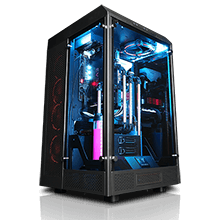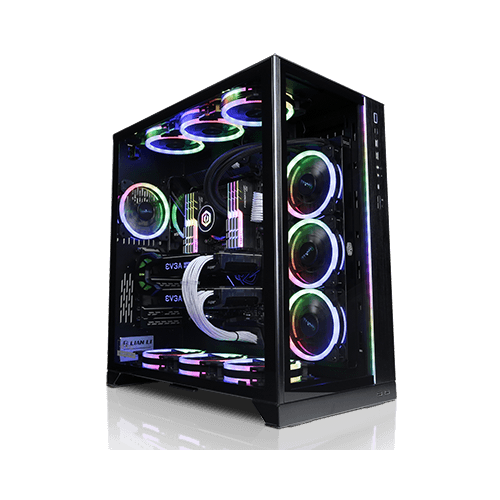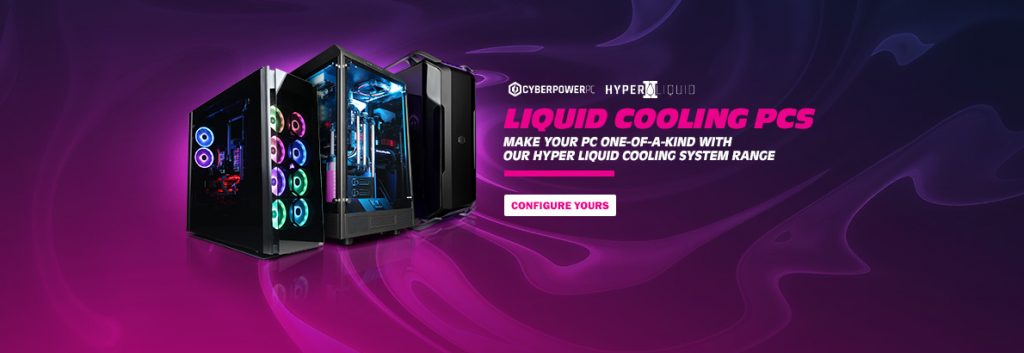
Temperature is responsible for most of the biggest problems in computing. Whenever a digital circuit crunches a number, it generates a little bit of heat. Cram enough circuitry into a space the size of an After Eight mint, and this effect can quickly escalate. It’ll make the conductive metals inside the chip more resistant, and this causes errors to creep in – and in extreme cases, it might fry the chip entirely. It’s necessary to put a PC cooling system in place to draw heat away from the chip and into the surrounding air. The simplest solution is passive cooling, which involves attaching a few metal fins to the unit, whose role is to dissipate heat. High-end RAM is housed in a casing which does precisely this.
We can take this a stage further by clamping a fan next to the radiator and blowing the hot air away from the fins. This is the method employed by the factory cooler that ships with most CPUs. It’s stumpy and cheap, but it does the job. If you’d like to take things further, you can invest in something beefier. It’ll do the same job, but a great deal more effectively.
For overclockers, and for everyone else
For overclockers, an aftermarket cooler is a virtual requirement. While it’s possible to overclock using the factory cooler, doing so will push your core temperatures higher. But even if you’re not overclocking, investing in third-party cooling makes a great deal of sense. Lower temperatures mean less resistance, lower failure rates and peace of mind before you even factor in the extra cycles they might facilitate.
[su_row][su_column size=”1/4″ center=”no” class=””] [/su_column] [su_column size=”3/4″ center=”no” class=””]
[/su_column] [su_column size=”3/4″ center=”no” class=””]
[/su_column][/su_row]
[su_spacer size=”10″]
The difference between an all-in-one and a custom loop cooling system
Most aftermarket coolers today use a form of liquid cooling. This works similar to an air-conditioning system, with coolant ferried between the unit and a radiator. By controlling the temperature of the coolant, we can control the temperature of the CPU – and without clamping the radiator directly to the core. That means we can make the radiator much bigger, and therefore more effective.
Water-cooling PC hardware is the most effective way of keeping temperatures under control – but for years, it was costly and cumbersome to implement. Nowadays, all-in-one coolers provide a neat-and-tidy alternative to traditional modular designs.
An all-in-one system, as you might expect, consists of a single unit. A custom-loop, by contrast, consists of several different components that must be assembled by the end-user, including pipes, radiators and pumps.
Each of these methods has its advantages and disadvantages. But which is the best for your liquid cooling PC needs? Let’s take a look.
The benefit of an all-in-one cooling system
Simplicity
The most obvious plus-point of an all-in-one system is its simplicity. With no additional components to worry about, a cooler of this sort can be installed with little fuss. What’s more, you won’t have to worry about making mistakes during installation.
An all-in-one liquid cooler consists of two blocks connected by a pair of tubes. One block is small and built to clamp onto your CPU. The other is larger and comes with fans attached. Inside the larger block is the radiator. The hot coolant is sucked from the processor to the radiator, where it’s cooled before being shunted back via the other pipe, just like in a custom loop.
Reliability
Another advantage of a closed-loop is that failure is less likely. They’re put together to exact tolerances at the factory, and you’ll be protected in the rare instance of a defect. If you’re putting together a system yourself, then there’s a risk of failure, particularly if you lack the experience to avoid mistakes. This is especially worrisome when a mistake could see coolant spurting all over your motherboard.
Cost
Finally, it’s worth mentioning that all-in-one coolers are significantly cheaper than custom loops. The former might set you back £50; the latter might cost 10 times that. If you need to make every penny count in your new build, it might be that this difference will be better invested elsewhere.
The benefits of a custom-loop PC cooling system
Flexibility
A custom loop will provide you with (you’ve guessed it) a far greater scope for customisation, and therefore greater scope to push the envelope. Extraordinary rigs require extraordinary cooling solutions. There’s little point in spending £2,000-£3,000 on a PC and then a pittance on the cooling.
Most notably, custom loops allow for different-sized radiators to be used. This may be worthwhile if you’ve got space inside your case to accommodate them. A standard PC fan is 120mm wide, and the largest custom radiators can stretch across four of them. If that’s not enough, you can put multiple radiators in the same loop. Anything’s possible!
GPU cooling
Another major advantage of a custom loop is that you’ll be able to cool multiple components from a single loop, and thereby avoid a tentacular mess of pipework clogging up the centre of your case. This means you can put the GPU on the same cooling loop as your CPU, just like the radiators attached to your central heating.
In multi-card set-ups, this is the tidiest option – you just need a separate cooling block for each. If you want to go to extremes, you can even liquid-cool your RAM (although the return you’ll get on the investment is, shall we say, less than convincing).
Flow Rates
One of the more interesting things you might notice when assessing your options is the advertised flow rate. An open-loop pump/reservoir like Corsair’s XD5 might be able to zip 800 litres an hour through the loop; while the same manufacturer’s all-in-one models can shift closer to 120. This is close to an order-of-magnitude difference, and it’ll mean appreciable differences on your core temperatures, provided that there’s enough radiator to cool the liquid by the time it arrives back at the CPU.
[su_row][su_column size=”1/4″ center=”no” class=””] [/su_column] [su_column size=”3/4″ center=”no” class=””]
[/su_column] [su_column size=”3/4″ center=”no” class=””]
[/su_column][/su_row]
[su_spacer size=”10″]
The difference between a soft tube and a rigid tube
The tubes through which your coolant passes from the radiator to the CPU can be either solid or flexible. There are aesthetic differences between the two, but practical ones, too.
The biggest of these stem from the ease of handling. Soft tubing can be easily shaped to fit the confines of your case. However, there’s a danger of kinks forming if you don’t know what you’re doing. Moreover, the plasticiser (the chemical that makes plastics movable) has a tendency to leak over time, causing the tube to turn cloudy.
Hard tubing certainly looks the part – if you shape it the right way, your system can become a thing of beauty. That said, shaping tubing of this kind requires serious skills and serious tools, particularly if you’re working with glass. If you’re a liquid water-cooling neophyte, this may be a tough ask.
A side effect of a harder material is that it can’t be compressed, and therefore can’t have compression fittings. This makes it slightly less forgiving when it comes to leaks – another reason to bring in an expert.
If you’re willing to pay a little extra and have a professional fit the entire system, the results can be spectacular, particularly if you’ve got a matching RGB solution in place. Moreover, the system can often be recycled, at least in part, between successive builds – which will help to take some of the edges off the considerable outlay.
What temperatures should I be getting?
The relationship between performance and temperature depends on a whole slew of factors, making it difficult to say for certain how hot a particular chip should be running. The interface between the chip itself and the integrated heat spreader (the metal case that you actually put compound on) matters, as does the way you apply thermal compound, and the make-up of the compound itself. Some chips are inherently hotter than others, and thus less suited to overclocking.
Which is better, all-in-one or custom loop?
A custom-loop system is undoubtedly fiddlier and more time-consuming than an all-in-one. But for many users, the differences in performance are worthwhile. If you’re using multiple overclocked graphics cards, then a custom loop is almost a necessity – but even in more modest systems, the benefits can be tangible. By opting for one of the custom-loop systems made by experts, you’ll ensure that your machine has been rigorously tested and achieves the temperatures you’re looking for.[su_spacer size=”10″]
